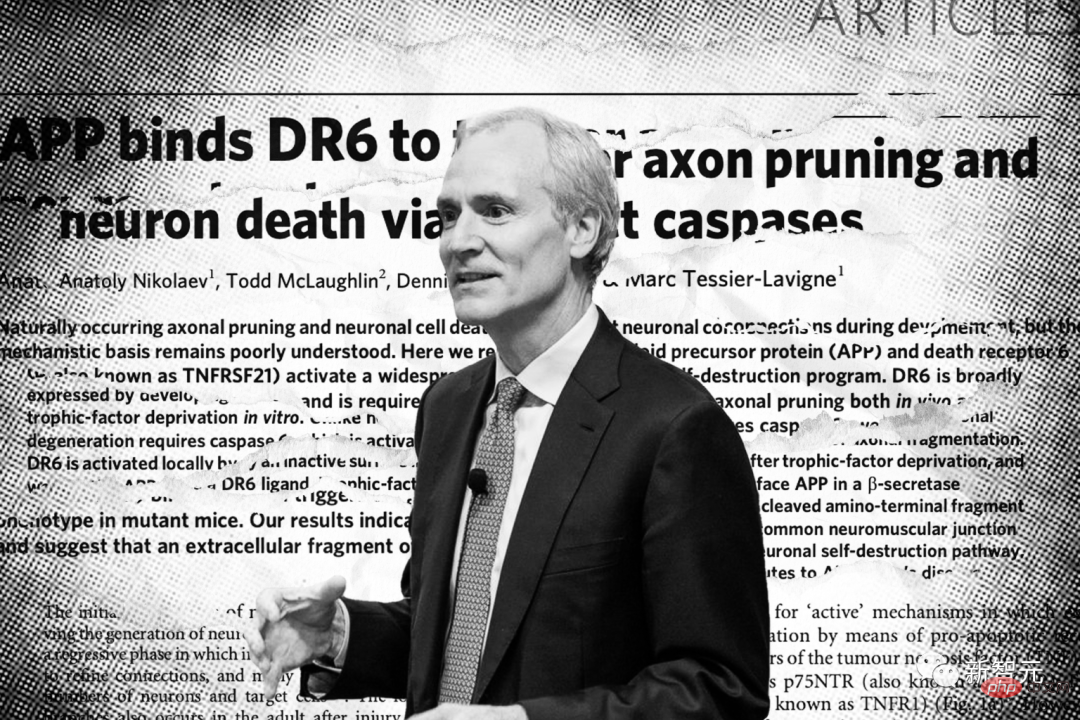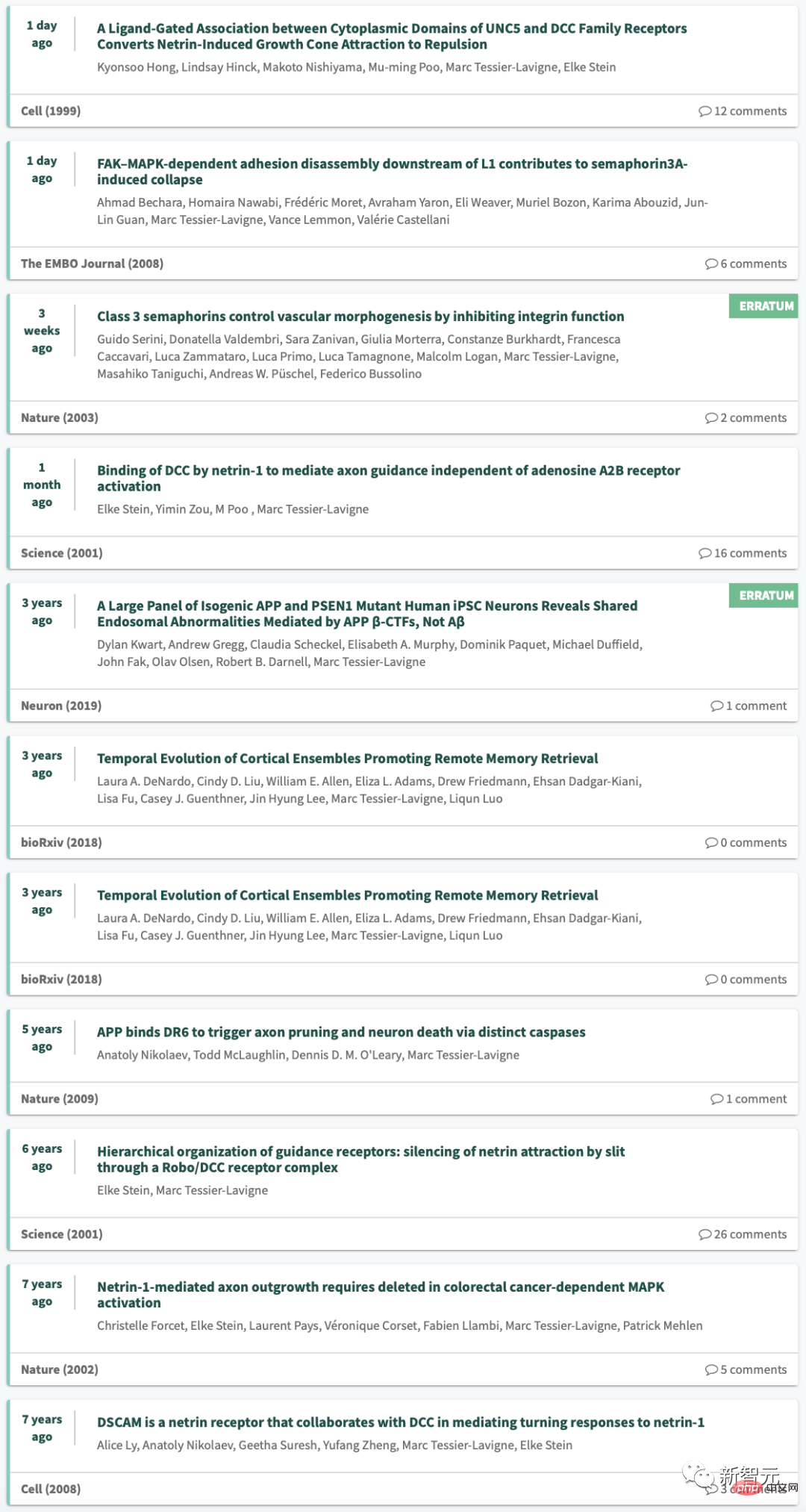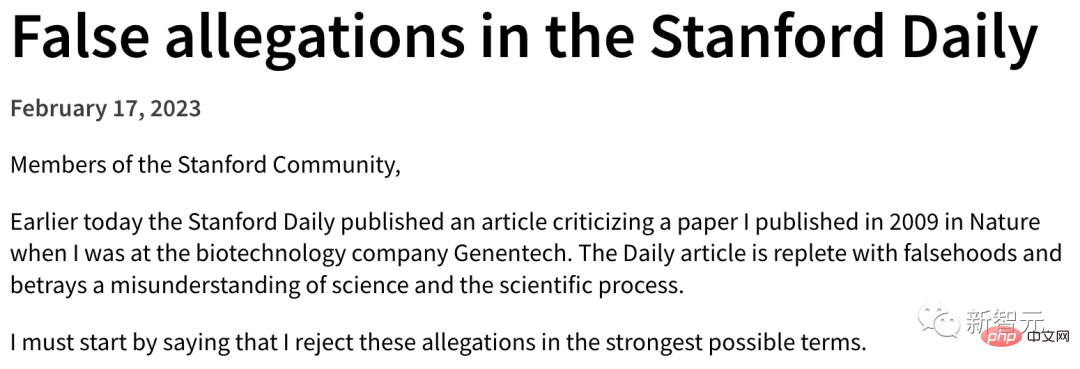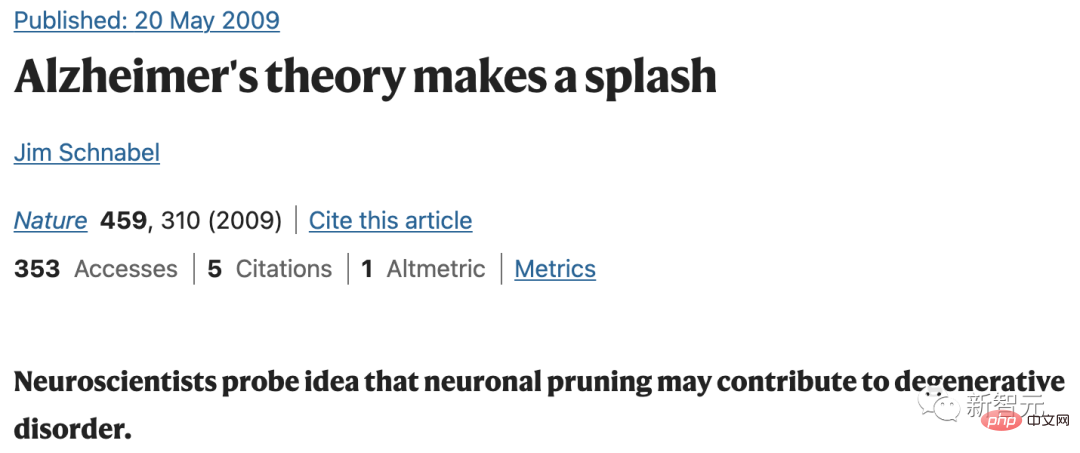
A 14-year-old unsolved case is still full of doubts.
The protagonist of the story, Marc Tessier-Lavigne, now the president of Stanford University, was strongly accused of academic fraud by his daily newspaper "The Stanford Daily".
The principal sent an angry email to all Stanford teachers and students on the 17th, eager to prove his innocence.

In 2009, then-Biotech Marc Tessier-Lavigne, an executive at the company Genentech, co-authored a paper published in Nature.

Paper address: https://pubmed.ncbi.nlm.nih.gov/19225519/
This paper claims to have discovered a potential cause of brain degeneration in Alzheimer's disease patients.
Genentech wrote in its annual letter to shareholders: "As a result of this research, we are working to develop antibodies and small molecules that may lead to a new entry point in the treatment of Alzheimer's. Alzheimer's disease, helping the millions of people currently suffering from this devastating disease."
But then four of the company's scientists discovered something was wrong: After multiple attempts, The results of this study have never been replicable.
Then, in 2011, the paper became the subject of an internal review by Genentech’s Research Review Board, led by two senior scientists and two scientists who were also executives.
They concluded that some of the data in the paper was fabricated and that Tessier-Lavigne had been trying to cover up this fact.

##Stanford University President Marc Tessier-Lavigne walked across Stanford’s Main Quad and declined to be interviewed
Tessier-Lavigne denies both accusations.
Genentech also expressed solidarity with Tessier-Lavigne. The company said in a statement: "We conducted a detailed investigation into the allegations and reviewed the minutes of the November 2011 RRC meeting. No fraud or misconduct was found."
However, Genentech also acknowledged that "given that the incident occurred many years ago...our current records may not be complete."
However, although Genentech denied Tessier-Lavigne’s fraud, it also canceled the research based on the paper’s findings.
Till Maurer, who served as a senior scientist at the company from 2009 to 2018, was originally assigned to develop a drug based on the 2009 paper, but his supervisor told him that the project The falsified data was cancelled.
In 2016, Tessier-Lavigne became the president of Stanford University.

The Stanford University Board of Trustees has been investigating Tessier-Lavigne since late November 2022.
There was another paper, with more serious accusations. The article dealt with what was once considered the most promising treatment target for Alzheimer's disease, and again, those involved in the review found that Tessier-Lavigne was trying to withhold key details.
Does internal review actually exist? Various opinions seem to have become Rashomon.
The client, Tessier-Lavigne, has repeatedly refused the reporter’s requests for email interviews and face-to-face interviews. His attorney, Stephen Neal, responded to questions sent to Tessier-Lavigne in writing.
"Dr. Tessier-Lavigne was not aware of any internal investigation," Neal wrote. "Given that there was no investigation of this paper, Dr. Tessier-Lavigne does not acknowledge any of the allegations made by the anonymous scientists."

# #Genentech confirmed in a written statement to the Stanford Daily that an internal review was conducted within the company in 2011, but the incident had not previously been made public. Genentech will describe the review as "routine."
When The Stanford Daily asked a scientist who was on the research review committee if this was true, his response was, "No, no, no."
Genentech spokesperson Susan Willson wrote: "There have been no formal investigations, allegations, claims or complaints regarding the falsification of the 2009 Nature paper." "The project underwent a periodic review by the Genentech Research Review Committee (RRC) , just like any other regular review."
So why did the review committee terminate this study? The spokesman said this was due to poor results from Genentech's genetic experiments.
Some experts say that scientific journals and institutions have historically been unwilling to investigate alleged academic misconduct, especially the behavior of powerful scientists.
Even when journals respond, investigations are slow, bureaucratic and often completely confidential, according to several researchers familiar with the retraction process.
Already questioned in 2008Seven years ago, some anti-counterfeiting professionals questioned Tessier-Lavigne’s paper.
The "image error" in the paper was first discovered on the academic anti-counterfeiting website PubPeer. Some of the posts noted that various Western blots documenting the presence of proteins were repeated in more than one image or had been modified.
Of course, without conclusive evidence, these problems do not necessarily mean that the author has committed academic misconduct, and may just be unintentional mistakes.
However, there were as many as 11 papers that were suspended.

At that time, Stanford University announced a formal investigation into neuroscientist Marc Tessier-Lavigne, the president of the school, due to suspicion of "tampering with images."
Initially, while Stanford acknowledged there were problems with the papers, it downplayed Tessier-Lavigne’s role in potential misconduct in a statement: Spokesperson Dee Mostofi said at the time that these The errors either did not involve Tessier-Lavigne or "did not affect the interpretation of the data, results, or paper."
However, as the incident gradually heated up, Stanford later changed its tone and said that the school would conduct an investigation overseen by the school's board of trustees.

At the request of the Stanford Daily, Matthew Schrag, an Alzheimer's disease expert with no interest in the matter and no knowledge of the matter, carefully reviewed the paper and concluded that some of the Alzheimer's disease-specific conclusions were shown to be inaccurate in later studies.
But Schrag also said that this does not prove that the author of the paper committed fraud or other misconduct.
Four senior scientists at Genentech said an investigation proved that the scientific facts that led to the conclusions of the 2009 paper were fabricated.
According to Nature's policy, the paper will be withdrawn.

##Excerpted from
Support Publication ethics committees at journals around the world recommend that papers should be reviewed "where there is clear evidence that the findings are unreliable, whether due to significant error (computational error or experimental error) or to fabrication (data) or falsification (images)" withdraw.
But Genentech scientists say Tessier-Lavigne is "unwilling to clean up the mess."
Tessier-Lavigne’s lawyer Neal insisted that the conclusion of the 2009 paper was untenable and was part of the “normal process of scientific research” and was not artificially false.

was first reported by the "Stanford Daily" in November. The board of trustees launched an investigation into the matter after several papers co-authored by Stanford University President Tessier-Lavigne allegedly contained information about doctored images.
Since then, independent scientists have raised concerns about other papers written by Rector, and the journals Science and Cell published "Editorial Expressions of Concern" on three of Tessier-Lavigne's papers. Concern).
The "Stanford Daily" report and Tessier-Lavigne's defense come as the president is under increasing scrutiny.
Faced with doubts from the "Stanford Daily", Marc Tessier-Lavigne issued a notice to all teachers and students on February 17, stating that these four former colleagues had accused him of "tampering with data" in his research. "The accusation is simply a "replete with falsehoods."
"I reject in the strongest possible terms the accusations of misconduct against me," Tessier-Lavigne wrote. "I believe that a full presentation of the facts will prove my position."

##Article address: https:/ /tessier-lavigne-lab.stanford.edu/news/false-allegations-stanford-daily
Tessier-Lavigne claimed that the "Stanford Daily" We criticized our 2009 paper on the grounds that we did not understand all aspects of the model when we first published it. However, we have re-examined the original model in the research report we wrote later, and "the subsequent paper fully verified and Extends our revised conclusions"."This is a ridiculous criticism for anyone who knows how science works," Tessier-Lavigne wrote.
An irreproducible "miracle"
Two days after the publication of the 2009 paper, Genentech called it "a completely new way to study Alzheimer's" in a letter to shareholders. Pioneering basic research into the cause of Heimer's disease."
At the time, Nobel Prize winner Paul Greengard believed that this would "have a major impact on the field of Alzheimer's disease." In addition, Nature also published an article titled "Alzheimer's Disease Theory Causes Sensation."

The research was conducted with Anatoly Nikolaev, a postdoctoral student at Genentech, and two Salk Institute scientists , who provided expertise for some of the experiments and were supported by government grants.
After the paper was published, Nikolaev was hired as a scientist at Genentech, and Tessier-Lavigne, then executive vice president of research drug discovery, was promoted to chief scientific officer, responsible for managing more than 1,400 scientists.
This paper received 1,245 citations, while most articles in this field have less than 10 citations.

Shortly after the paper was published, Tessier-Lavigne and Nikolaev submitted a 187-page document to the World Intellectual Property Organization. The patent title is "method for inhibiting neurodegeneration".
On the same day, they also filed patent applications in the United States, Brazil, Israel, Canada and Australia, hoping to use their research to develop life-saving drugs.

However, this research did not lead to a cure for Alzheimer's disease. Several patent applications, including U.S. patent applications, were abandoned after internal review. By 2011, some experts studying Alzheimer's disease also began to raise doubts.
Tessier-Lavigne was on Genentech’s research review board until she left the company, according to scientists who sat on the review board.
And Tessier-Lavigne characterized the internal review as "some experienced biologists intentionally reproduce the key findings in the paper" and "re-examine the key findings in the paper."
Till Maurer, a senior scientist responsible for drug development based on this research, recalled that the company had launched a research and development plan for related drugs, but the team was suddenly disbanded.
In this regard, Maurer pointed out that this was because the review board discovered that "the experimental data had been tampered with." Although he was unable to provide relevant evidence because he was unable to retain all the documents due to his resignation, he was convinced that the term "tampering" referred to errors in the paper.

Specific problems with the paper relate to its central conclusion, according to the four scientists responsible for the review.
The paper's experiments claim that the amino-terminal fragment of amyloid precursor protein (N-APP) binds to DR6, and this binding leads to neurodegeneration.
But later studies published by Tessier-Lavigne’s laboratory and other research groups showed that this conclusion was inaccurate. As suggested by experiments published in 2015, the APP protein binds to DR6 at the E2 site.
However, the N-APP fragment used in the 2009 study did not include the E2 site, which means that it is impossible for DR6 to bind to this fragment and to produce the results described in the paper. conclusion.
The Stanford Daily wrote angrily: "Fabricating data is the most intolerable thing in the entire scientific community. According to a 2009 report by the National Academy of Sciences The report stated that this kind of fraud violated basic research standards and social values."
Genentech executives involved in the review said that in the face of such results, company leaders have been urging Tessier- Lavigne retracts the paper.
Genentech values its reputation and credibility, but what the principal hopes most now is to remain quiet.

But the current status quo is that this paper has not been corrected or withdrawn, and it still exists.
Naure editor-in-chief Magdalena Skipper said in a statement to the Stanford Daily, "For confidentiality reasons, we generally do not comment on the details of cases. But what we can confirm is that we No internal investigation report was received related to the article."
Those with knowledge of the review were reportedly sworn to confidentiality.
I don’t think anyone at Genentech would be interested in this publicly because it would damage the reputation, Maurer said.
A senior scientist also said that retracting the paper would be seen as "tarnishing the reputation of Tessier-Lavigne/Genentech."
In addition, the scientists also discovered something interesting: Although Tessier-Lavigne did not issue any retraction statement, he avoided this in several subsequent articles. Research.
Genentech scientists said that while the research was halted internally at the company, it was frustrating that the issues raised by the review were not disclosed publicly.
"It's very important that this kind of thing gets into the public domain," Maurer said. Other scientists agree.
When Vishva Dixit, vice president of Genentech and a member of the committee that reviewed the DR6 study, was asked about this by the Stanford Daily, she said she had nothing to say and asked them to go to Genentech. News office.
The Stanford Daily contacted dozens of members of the review board, but no one responded.
Genentech said in a statement, "Our company was founded on the principles of scientific integrity, and we have upheld this philosophy throughout our 45-year history. We will not tolerate papers There is fraud in it."
Currently, Tessier-Lavigne's papers confirmed by Stanford University as "problematic" have been downloaded tens of thousands of times, including his most cited in neurobiology some work. None of these papers have been retracted or corrected.
The above is the detailed content of Academic misconduct accusations against Stanford president escalate again! A 10,000-word long article in the school newspaper questioned fraud, and the principal angrily sent an email to the whole school to prove his innocence.. For more information, please follow other related articles on the PHP Chinese website!




